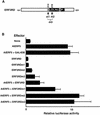Repression domains of class II ERF transcriptional repressors share an essential motif for active repression
- PMID: 11487705
- PMCID: PMC139139
- DOI: 10.1105/tpc.010127
Repression domains of class II ERF transcriptional repressors share an essential motif for active repression
Abstract
We reported previously that three ERF transcription factors, tobacco ERF3 (NtERF3) and Arabidopsis AtERF3 and AtERF4, which are categorized as class II ERFs, are active repressors of transcription. To clarify the roles of these repressors in transcriptional regulation in plants, we attempted to identify the functional domains of the ERF repressor that mediates the repression of transcription. Analysis of the results of a series of deletions revealed that the C-terminal 35 amino acids of NtERF3 are sufficient to confer the capacity for repression of transcription on a heterologous DNA binding domain. This repression domain suppressed the intermolecular activities of other transcriptional activators. In addition, fusion of this repression domain to the VP16 activation domain completely inhibited the transactivation function of VP16. Comparison of amino acid sequences of class II ERF repressors revealed the conservation of the sequence motif (L)/(F)DLN(L)/(F)(x)P. This motif was essential for repression because mutations within the motif eliminated the capacity for repression. We designated this motif the ERF-associated amphiphilic repression (EAR) motif, and we identified this motif in a number of zinc-finger proteins from wheat, Arabidopsis, and petunia plants. These zinc finger proteins functioned as repressors, and their repression domains were identified as regions that contained an EAR motif.
Figures






References
-
- Friedman, J.R., Fredericks, W.J., Jensen, D.E., Speicher, D.W., Huang, X.P., Neilson, E.G., and Rauscher III, F.J. (1996). KAP-1, a novel corepressor for the highly conserved KRAB repression domain. Genes Dev. 10, 2067–2078. - PubMed
MeSH terms
Substances
Associated data
- Actions
- Actions
- Actions
- Actions
- Actions
- Actions
- Actions
- Actions
- Actions
- Actions
- Actions
LinkOut - more resources
Full Text Sources
Other Literature Sources
Molecular Biology Databases

